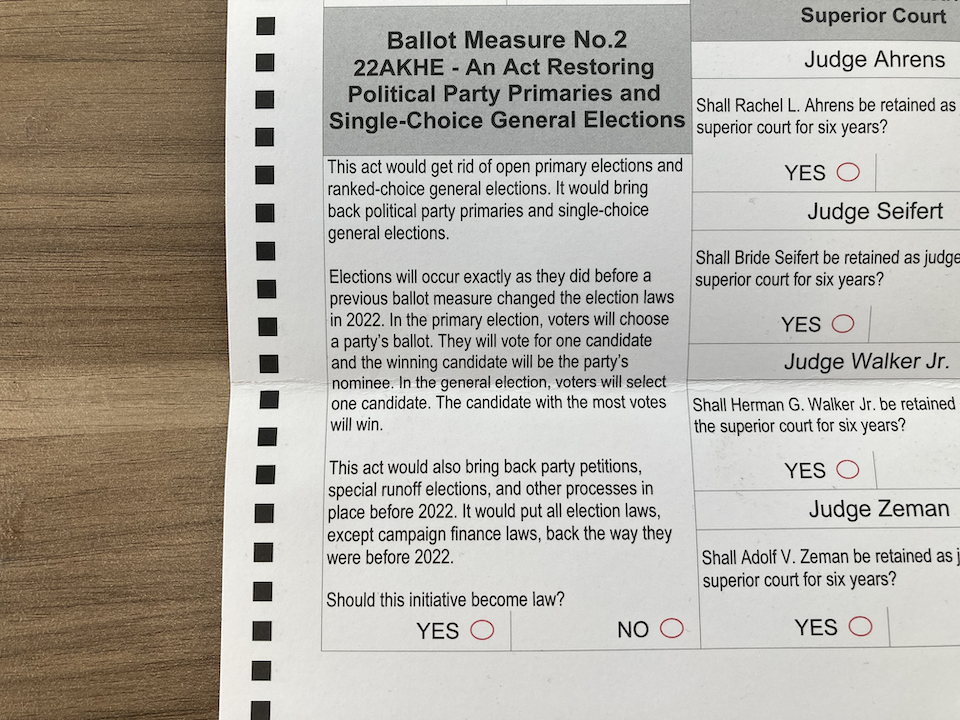![]()
The language of Ballot Measure 2 appears on Alaska’s 2024 absentee ballots. The measure would repeal the states open primary and ranked choice voting system. (Photo by Andrew Kitchenman/Alaska Beacon)
More Alaskans voted to repeal the state’s open primary and ranked choice voting system than voted against the measure, among the roughly 70% of the votes counted through early Wednesday.
There were 120,597 votes to pass Ballot Measure 2 and 115,110 against it, though it remained too close to call, with a rough estimate of 100,000 ballots left to count.
Ballot Measure 2 would repeal the voting system that’s been in place since voters approved it in 2020. If the measure passes, political parties would control who could vote in party primaries, and voters would have only one choice in the general election.
Supporters of the repeal said the new system confused voters and had been promoted by interest groups from outside of Alaska. Opponents said the voting system is better suited to the large number of Alaskans who don’t belong to any party and that repealing it would increase the power of party elites.
The group opposing the ballot measure, No on 2, raised nearly 100 times as much money as proponents, with the majority coming from out-of-state groups. Businesses involved in Alaska’s tourism industry opposed the measure.
No on 2 raised nearly $14 million, according to its most recent filing, while Yes on 2 raised just over $150,000. The No on 2 funding came from some of the same sources that supported the enactment of the open primary and ranked choice voting system in a ballot measure in 2020.
No on 2’s closing argument in TV and social media prominently featured Republican U.S. Sen. Lisa Murkowski, who defeated Republican nominee Joe Miller with a write-in campaign in 2010.
“As Alaskans, we value our independence,” Murkowski said in one ad. “Sixty percent of Alaskans choose not to join a political party. Ballot Measure 2 limits our freedom to vote for the best candidate, regardless of party. So join me in rejecting politics as usual.”
Supporters of the measure have argued the new system introduced unnecessary complications to voting.
“Want your vote to count without the confusion? Vote yes on 2,” the announcer said in an ad. “Ranked choice voting is complicated and leaves many voters frustrated. By voting yes on 2, we can return to a simple, clear process: just one vote, for the candidate you believe in.
Those who want to keep the current voting system have pointed to Alaska as a national model for reducing partisan divides. Outside attention increased when Democrat Mary Peltola won the first election under the system, an August 2022 special election held after the death of Congressman Don Young. She was the first Democrat to win a statewide race since Mark Begich in 2008.
The ballot measure drew support from Alaska Republicans, who have said that it leads to success for those who are “Republicans in name only.” Recent polling found that Republicans were the only group of voters who supported the repeal measure.
Many thousands of ballots sent by mail, as well as questioned ballots and early votes cast in the four days before the election, still must be counted. The results won’t be certified until after the 15-day period in which ballots that have been mailed by Election Day from overseas can still arrive at the Division of Elections.
How Alaska votes
In the system, all candidates compete in the same August primary, regardless of which party they belong to, or if they’re in no party at all. The top four finishers — after those who choose to end their campaigns drop out — advance to the general election. Then voters can rank the candidates.
If no candidate receives more than 50% of the vote in the first count, then the Division of Elections tabulates the ranked choices. Those who cast their top preference for the trailing candidate have their votes transferred to the next choice, with the process repeating until the candidate who finishes first between the final two wins.

